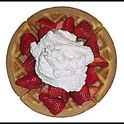Is Buttermilk always "low fat"?
I wanted to try a recipe that called for buttermilk but all I could find was labelled "low fat". Can I use that? is there any other kind?
21 Comments
GreywackyOctober 7, 2019
I am a very novice baker. I have a cake recipe that calls for whole buttermilk, and I could only find low fat buttermilk. Do I need to add more fat to the recipe, (maybe, butter?), compensate?
ScottMarch 16, 2019
I used grocery store 2% fat buttermilk to make some Irish soda bread yesterday. It didn't rise like I'm used to. My question is... should I use that low-fat buttermilk or resort to full fat milk with lemon juice or vinegar as a buttermilk substitute? I was very disappointed with both my loaves of soda bread. Oh, and I don't live where I can get the "real" buttermilk some of you were discussing.
ChefOnoAugust 9, 2013
Maedl, I didn't say you couldn't make cultured buttermilk from whole milk, just that it's not traditional. If I've got an argument, it's with the term "full fat" in this context as there's almost no fat in churned buttermilk. I am interested in the reason for such a product.
Jill, welcome. For your purpose you want the cultured variety for its acid.
June, there are two kinds of churned buttermilk -- which did you enjoy? The more traditional began to sour during the time it took the cream to separate. That was common before modern equipment became widespread. When I was a kid we got our milk from the dairy, drawn off the cooler (the first stage after milking), so the butter and the buttermilk were sweet. That stuff you can whip up in about 5 minutes. Personally, I've never been a fan but pour me a glass of milk right under that cream!
cookbookchickAugust 9, 2013
I am a Washington DC native who grew up on Sealtest milk. In fact, my mom modeled for one of their print ads back in the day. I believe it is only distributed in the DC/MD/VA region.
Diana B.August 9, 2013
Why a lot of milk products aren't available in pints is a mystery to many of us, paseo. A chunk of my freezer is given over to small quantities of frozen milk, half-and-half, and buttermilk because I can't always use up a quart before things start to decline.
sexyLAMBCHOPxAugust 9, 2013
I bought the buttermilk powder but have yet to try it out. It's been in my fridge waiting for something. Maybe I'll start with a buttermilk dressing or use it to brine chicken. My local Whole Foods stocks full fat buttermilk from a local dairy farm.
paseoAugust 8, 2013
In New England Kate's buttermilk from churning butter is available in supermarkets from a company that makes butter in Old Orchard Beach, Maine It is less than 1% milk fat and is excellent for baking and drinking. But if you are soaking chicken in buttermilk (better than brining in my opinion) cultured from the dairy section is fine. We in NE are fortunate to have access to Kate's and Butterworks (from VT) buttermilk - which is delicious, expensive and actually comes in a pint. Why all buttermilk is not available in pints is way beyond me.
Diana B.August 8, 2013
I hear you, Jill! Seems there's always more controversy on food questions here, but we always learn something. I was interested in the suggestions on finding non-cultured buttermilk, so I got all excited when I saw dymnyno's comment, because Straus products are distributed in my area, but I don't see buttermilk listed as one of their products on their website (I've emailed them for more info). Sadly, I've never seen Sealtest marketed where I live. I remember reading some time ago of a dairy in the northeastern U.S. that made non-cultured buttermilk, but I don't remember the name and their distribution was very small.
I did find this online, which bears out what Chef Ono says about buttermilk being naturally low-fat. http://www.heracliteanriver.com/?p=424
I did find this online, which bears out what Chef Ono says about buttermilk being naturally low-fat. http://www.heracliteanriver.com/?p=424
caninechefAugust 8, 2013
my first public venture on food 52, I never guessed buttermilk was so controversial. For the record I was thinking of trying fried chciken, the kind you soak in buttermilk.
creamteaAugust 8, 2013
Sorry to disagree with you all. If Jill Hamilton is making a recipe that was originally made with cultured low fat buttermilk, a non-soured version won't taste the same. A buttermilk salad dressing, for example, made with regular sweet milk won't taste right (I'm kind of thinking of my "dilled crunchy sweet corn salad with buttermilk dressing" on F52). I'm happy with supermarket buttermilk for pancakes too, I like it better than sweet milk soured with vinegar. Depends on what you are making, I guess.
MaedlAugust 8, 2013
Chef Ono, since modern buttermilk is cultured with bacteria, full fat milk can be used as well as low fat milk. I am pretty sure the Sealtest full fat butter milk comes in an orange carton; perhaps it is not marketed nationally.
ChefJuneAugust 8, 2013
ChefOno, for someone who grew up drinking the fresh buttermilk after the butter was churned, the stuff that comes in cartons in the grocery store these days (different when I was a kid!) just doesn't taste like buttermilk.
ChefOnoAugust 8, 2013
Cultured buttermilk isn't any less "real" than yogurt.
Churned buttermilk is low fat by nature -- the fat having gone into the butter. Cultured buttermilk is low fat by tradition, to mimic the original stuff. If your use is for baking, do not substitute regular milk as that would throw off the acid balance. For Crème Fraîche, any product with live cultures will work but I'd choose the cultured variety because the bacteria are controlled. There is another type of buttermilk, powdered buttermilk, which keeps "forever" in the refrigerator so it's always at hand and, unlike liquid products, doesn't lose its buttery qualities over time.
MaedlAugust 8, 2013
Sealtest makes a high fat buttermilk that is excellent, so no, not all buttermilk is lowfat. Lucerne (Safeway house brand) makes a decent low fat buttermilk if that’s what you want. Me? I’ll go for the real stuff.
CopernicousAugust 8, 2013
DO NOT use the low fat buttermilk from the supermarket. It is flavorless and your recipe will suffer. Just use regular milk if you can't find the real stuff.
dymnynoAugust 8, 2013
If you live near the SF Bay area or anywhere where the Straus Family Creamery distributes their products they produce and sell full fat buttermilk. Cowgirl Creamery makes their cheeses using Straus milk.
ChefJuneAugust 8, 2013
Monita's right. That's the stuff you find in the grocery store. However, it isn't real buttermilk, it's manufactured. REal buttermilk, which you can get from a dairy store, is made from the "milk" that's left after cream is churned into butter. So that has higher fat content, and WAAAAY better flavor. In fact, I can't bring myself to use that grocery store stuff any more. And for making creme fraiche, you need the real buttermilk.
MonitaAugust 8, 2013
Meant to add - that's the buttermilk you want for your recipe
MonitaAugust 8, 2013
Yes, the kind you find in the supermarket is always low-fat
Showing 21 out of 21 Comments
Recommended by Food52
Popular on Food52
Continue After Advertisement







